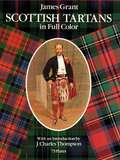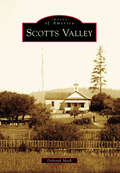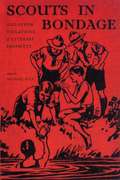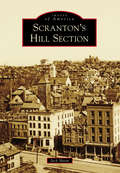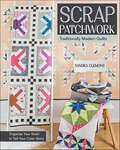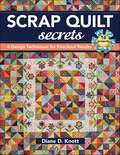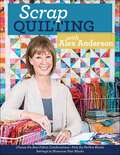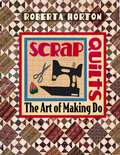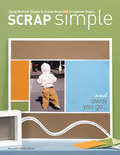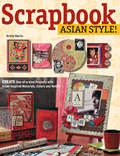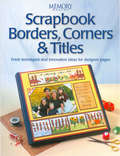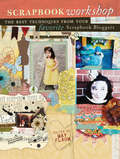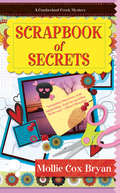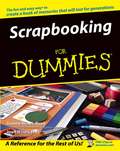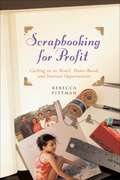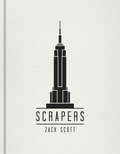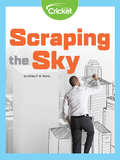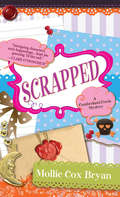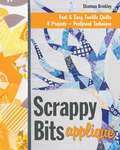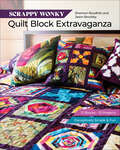- Table View
- List View
Scottish Tartans in Full Color (Dover Pictorial Archive)
by James GrantThe tartans of 72 Highland clans are presented in full-page, full-color, large-format illustrations. With a new introduction to tartans by J. Charles Thompson, Fellow of the Scottish Tartan Society and a noted authority in the field. A must for costume, textile and fashion designers and historians, and an eye-filling pleasure for all.
Scotts Valley (Images of America)
by Deborah MuthNestled among the spreading oaks of Santa Cruz County, just north of Monterey Bay, lies the city of Scotts Valley. First used as a hunting and camping spot on a Native American trading route, and later a stop on the stage route over the Santa Cruz Mountains, Scotts Valley has a long tradition of providing respite to weary travelers. Hiram Scott purchased the 4,447-acre Rancho San Agustin in 1850, built the community's first wood-frame house, and sold parcels of land that became dairies, farms, ranches, and lumber mills. In the 20th century, with the popularity of the family automobile, several attractions were opened throughout the valley. Travelers escaped the summer heat by flocking to the Tree Circus, Santa's Village, and the Lost World. Today, Scotts Valley remains a family-oriented community offering small-town charm and hospitality.
Scouts in Bondage: And Other Violations of Literary Propriety
by Michael BellStep inside Michael Bell's antiquarian bookshop, stocked with rare and fine collectibles of infinite variety, from the Book of Blank Maps,With Instructions, to Autobiography of the Best Abused Man in the World. By perusing these curious works from bygone times, inquiring readers will be rewarded with instruction on such rarely understood pursuits as Single-Handed Cruising and Girls' Interests. A treasure trove of the best of bookmaking, here is a library of laughs.
Scranton
by Roger Dupuis II Cheryl A. KashubaAfter incorporation in 1866, Scranton demonstrated an indomitable spirit that made it the Electric City and the Anthracite Capital of the World. Nestled in the scenic Lackawanna River Valley, Scranton carried that spirit through the changing economic landscape of the mid-20th century as its coal, railroad, and textile industries declined. In a cityscape that recalls its past, Scranton continues to find creative uses for its iconic structures. The community of Scranton embraces growth and change while celebrating its rich heritage with traditions like trips to the Saturday farmers' market at the historic Iron Furnaces, rides along the old Laurel Line trolley tracks to a RailRiders baseball game, celebrations of rich ethnic heritage at festivals throughout the year, and many more.
Scranton's Hill Section
by Jack SheanThe hills east of Scranton's downtown are home to one of the most eclectic and historic neighborhoods in America. Scranton's aptly named Hill Section developed over the course of the 19th and 20th centuries, from what was originally rugged terrain and dense forest to a socially diverse enclave. The area's close proximity to Scranton's commercial center and unparalleled views of the Lackawanna Valley attracted many of Scranton's wealthiest and most prominent citizens, including the city's namesake Scranton family, to build palatial mansions in a myriad of architectural styles on its many hills. Middle-class citizens soon followed suit, building smaller but equally splendid homes alongside their elite neighbors. To serve the Hill Section's growing population, civic leaders organized religious and community institutions, and local merchants developed commercial enterprises. Ultimately, the Hill Section became home to many well-known educational and medical centers, beautiful parks, and cultural establishments. In the 21st century, the Hill Section is still a thriving community that continues to preserve its heritage. Scranton's Hill Section tells the story of a distinctive neighborhood full of diverse people whose legacies are the true embodiment of American history.
Scrap Happy Sewing: 18 Easy Sewing Projects for DIY Gifts and Toys from Fabric Remnants (Retro Mama)
by Kim KruzichUse leftover fabrics to create amazing crafts—bags, bibs, quilts, toys, and much more! Kim Kruzich—a.k.a. Retro Mama—showcases her unique style and skill with color in this contemporary collection of eighteen simple sewing projects all designed to be made from leftover fabrics. These adorable handmade projects combine sewing, patchwork, applique, and embroidery and include bags, cushions and pillows, quilts, baby bibs, soft toys, organizers, bookends, and mats, all using Kim&’s charming motifs of owls, dolls, birds, clouds, fruits, bears, and more. Her trademark easy-to-follow visual instructions and full-size templates make these projects super accessible and achievable, so even beginners will be sewing gifts and toys in no time with a minimum of outlay on materials. In addition, gorgeous full-color photography will inspire you to get sewing, use up your stash, and brighten up your home—Retro Mama style!
Scrap Patchwork: Traditionally Modern Quilts
by Sandra ClemonsForget your troubles ... Come on, get scrappy! Sew 13 scrappy quilts with color palettes so sophisticated, you won’t believe they’re from scraps! Blending the best of modern and traditional quilting, these projects pair fresh fabrics with classic block designs and trusted techniques. Learn to organize your fabric and choose winning color combinations. Each quilt features design notes to help you get the look you want when “shopping” your own stash. Ideal for confident beginners, these patterns will keep your waste to a minimum and your creativity to a maximum. • 13 scrap quilts that blend the best of modern fabrics and traditional block construction • Organize your scraps! Tips for stash storage and designing with color • Graphic, sophisticated quilts for the confident beginner
Scrap Quilt Secrets: 6 Design Techniques for Knockout Results
by Diane D. KnottScrap to it! Turn your scrappy mess into a quilting success! Armed with the easy-to-use S.C.R.A.P.S. system (style, contrast, repetition, accent color, palette, and selvages), you’ll sew extraordinary quilts from every last bit of the fabric you love—even the tiniest scraps. Personalize 16 beginner-friendly quilts using the blank coloring pages, or apply the concepts to tackle any scrap quilt you want to make. These 6 must-know scrap secrets will forever change the way you look at scrap quilting! • 16 scrap quilting projects using 6 must-know design techniques • Use even the tiniest scraps of the fabric you love in a quilt you’ll treasure forever • Apply the S.C.R.A.P.S. system: style, contrast, repetition, accent color, palette, and selvages
Scrap Quilting with Alex Anderson
by Alex AndersonMake sensational scrap quilts with Alex Get scrappy with best-selling author Alex Anderson (more than 950,000 books sold!). Use your stash and your scrap bin to make 7 colorful quilts. Get in on Alex’s best scrap quilting secrets: which blocks and settings work best in scrappy quilts; how to combine fabric colors, prints, and values so your creations look exciting, not overpowering; and how to choose quilting motifs that highlight your design. • Complete instructions for 6 one-block scrap quilts, plus bonus sampler quilt • Inspiring gallery of 11 contemporary and antique scrap quilts • All quilts are easy enough for confident beginners Alex gives you a behind the scenes look at Scrap Quilting with Alex Anderson on C&T's YouTube channel.
Scrap Quilts: The Art of Making Do
by Roberta HortonAntique scrap quilts can be the most humble of quilts and, at the same time, the most complicated of all quilts to understand. Roberta Horton shows her techniques for making a scrap quilt, including how to free-hand cut shapes for a folk-art look. A selection of block patterns is provided, with possibilities for pieced, pieced-and-appliqued, and folk-art scrap quilts. Roberta shares advice on the interaction of fabrics within a quilt and how to choose just the right blocks. Unpretentious and honest - and, at the same time, beautitful - old quilts give today's quilters inspiration for coloration, composition, and fabric usage. *Important Note about PRINT ON DEMAND Editions: This title will be printed after purchase and will arrive separately from any in-stock items. Please allow approximately 2 weeks for USA delivery, with an additional 2 weeks for international shipments. Expedited shipping is not available on POD Editions. The printing quality in this copy will vary from the original offset printing edition and may look more saturated due to printing on demand by a high-quality printer on uncoated (non-glossy) paper. The information presented in this version is the same as the most recent printed edition. Any pattern pullouts have been separated and presented as single pages.
Scrap Republic: 8 Quilt Projects for Those Who Love Color
by Emily CierDon’t let those scraps sit there—sew them into these bursting-with-color projects from the author of Quilt Remix!Popular patternmaker Emily Cier sews up all the colors of the rainbow in her second collection of all-new patterns that include wallhangings and lap quilts.Divided into sections for the little stasher or the big stasher, this book gives separate cutting instructions for working with all scraps, or with all new fabrics. Emily brings a modern aesthetic to patchwork blocks with a joyful jolt of color!
Scrap Simple: Using Minimal Design to Create Beautiful Scrapbook Pages
by Hillary HeidelbergThe possibilities are endless when you scrap simple!Scrapbooking doesn't have to be fussy to be fun! For those with the desire but just a little bit of time, money or space, Scrap Simple is the must-have guide for chronicling all the important milestones and moments efficiently and economically. Perfect for beginners and veterans alike, this book makes it easy to give your pages that clean, simple look you want.View over 100 fresh, clean and uncluttered pages created with minimal productGet insider tips on creating cool pages in a flash using just basic tools and suppliesFind tips for choosing the best supplies when shopping and clever ways to make the most of what's already in your stashDiscover a new approach to using cardstock, patterned paper and embellishmentsLearn how to create simple two-page layouts, effectively use white space and incorporate text as a design elementScrap Simple makes it easy and fun to whip up fresh and modern scrapbook pages you'll cherish for a lifetime!
Scrapbook Asian Style!: Create One-of-kind Projects with Asian-inspired Materials, Colors and Motifs
by Kristy HarrisCreate fun and easy scrapbooks with an Asian flair!For scrapbookers tired of the same old same old, Scrapbook Asian Style! is chock full of new ideas, art, and inspiration for creating beautiful scrapbook craft.<P><P> It's perfect for experienced scrapbookers who are looking for something new to try in their layouts and for beginners who love the distinctive look of Asian design-or who simply want to make a splash with something special.With 150 projects from several accomplished scrapbook artists, such as a Buddha Light Switch Cover and Grandma's Origami Brag Book, this inspiring reference provides tons of ideas as well as step-by-step instructions on how to add pizzazz to layouts with Asian colors, motifs, fabrics, papers, text and brush work.Dozens of fun and exciting materials and techniques are used to give scrapbook layouts an Asian feel-including rub-ons, Asian characters, Chinese seals, die cuts, pressed flowers, patterned paper, handmade paper, washi paper, fabric, letter stickers, stamping, embossing, distressing, Chinese calligraphy, paper weaving, faux batiking, journaling, origami, digital effects and more.Scrapbookers of all levels will find ideas to document and celebrate special memories and occasions-including vacation, baby layouts, "all about me" pages, grandparents and grandchildren layouts, portraits, and anniversaries.
Scrapbook Borders, Comers & Titles: Fresh Techniques and Innovative Ideas for Designer Pages
by Memory Makers BooksFresh techniques and innovative ideas for designer pages Dress up your scrapbook pages with coordinating border, corner and title treatments to achieve a true designer look. Inside Scrapbook Borders, Corners & Tiles you'll find great ideas for pulling together dynamic scrapbook pages that showcase the best of times, year round. Dozens of fresh scrapbook page ensembles featuring 35 cutting-edge scrapbook techniques Reproducible project patterns Inspirational full-color seasonal and holiday scrapbook pages Easy-to-follow, illustrated step-by-step instructions Ideas for scrapbooking with today's hottest new page embellishments Pull out your scrapbook supplies and get ready to start Puttin' on the Ritz with the best-dressed pages in town. Scrapbook Borders, Corners & Tiles will show you how!
Scrapbook Secrets: Shortcuts and Solutions Every Scrapbooker Needs to Know
by Kimber McgrayGet the Scoop!Scrapbooking can always be quicker, less complicated and more productive. The secret is knowing the tips and tricks to do it right.Inside Scrapbook Secrets, author Kimber McGray reveals 50 simple secrets to help you scrap better, complete more layouts and have fun along the way. You'll learn insider info on the easiest ways to get the job done, how to make do in a pinch and new techniques that may surprise you. Plus, get 50 extra tips that will make you say "Aha!" over and over again. More than 75 projects illustrate these must-know secrets in action.Get the scoop on how to:Fit multiple photos on a pageFake a hand-stitched borderLine up a straight titlePick the proper inkAlter chipboardCover journaling mistakesAnd more!With all the info you need to know to be a better scrapper, Scrapbook Secrets will be your new best friend.
Scrapbook Workshop: The Best Techniques From Your Favorite Scrapbook Bloggers
by May FlaumA must-have for continuous scrapbooking inspiration! May Flaum has brought all your favorite and up-and-coming scrapbook bloggers together inScrapbook Workshop. Whether or not you follow blogs, this collection will serve as an idea book filled with projects and techniques you’ll use again and again. If you’re new to scrapbooking, this book will share not only ideas but also introduce you to people to watch and follow for continued inspiration. And for those experienced or blog-savvy scrapbookers, you will find fresh ideas from favorite bloggers, as well as new outlets to check out and people to watch. Scrapbook Workshopoffers— ·30 Fabulous Techniques: While free layout inspiration is readily available online, this book focuses ontechniques. The techniques are as diverse as the wide array of scrapbook bloggers that May has gathered here. ·Over 60 Pieces of Art:With plenty of variety from the 26 contributors, each bringing their own flair toScrapbook Workshop. From the messier to the digital, it’s all here! ·26 Contributors with Fantastic Blogs:A variety of contributors mean lots of styles and inspiration for every level of scrapbooker, and May has brought together the best of the best bloggers to share their techniques, layout, cards and more! InScrapbook Workshop, you’ll not only find new inspiration and new techniques, you will also find resources and meet 26 scrapbook bloggers to keep you inspired!
Scrapbook of Secrets (A Cumberland Creek Mystery #1)
by Mollie Cox BryanA small-town Virginia housewife and her scrapbooking circle investigate a suspicious death in this cozy mystery series debut.Having traded in her career as a successful investigative journalist for the life of a stay-at-home mom in picturesque Cumberland Creek, Virginia, Annie can&’t help but feel that something&’s missing. But she finds solace in a local &“crop circle&” of scrapbookers united by chore-shy husbands, demanding children, and occasional fantasies of their former single lives. And when the quiet idyll of their small town is shattered by a young mother&’s suicide, they band together to find out what went wrong . . .Annie resurrects her reporting skills and discovers that Maggie Rae was a closet scrapbooker who left behind more than a few secrets—and perhaps a few enemies. As they sift through Maggie Rae&’s mysteriously discarded scrapbooks, Annie and her &“crop&” sisters begin to suspect that her suicide may have been murder. It seems that something sinister is lurking beneath the town&’s beguilingly calm façade—like a killer with unfinished business . . .&“A scrapbook of zany small town life with characters you'll want to visit again and again in each new novel.&” —Emilie Richards, author of Sunset Bridge &“Imagine the housewives of Wisteria Lane sipping tea, scrapbooking, and solving murders, and you have this gem of a debut.&” —Lois Winston, author of Assault with a Deadly Glue Gun &“Intriguing characters, eerie happenings . . . Kept me guessing &‘til the end.&” —Clare O&’DonohueIncludes tips and a glossary of terms for the modern scrapbooker!
Scrapbooking For Dummies
by Jeanne Wines-Reed Joan WinesScrapbooking is sweeping the nation! This hot hobby is a fantastic way to preserve your memories and family history-and have a lot of fun doing it. Now, here's an easy-to-follow guide that will have you creating great scrapbook projects in no time. Scrapbooking For Dummies is perfect for you if you're a new scrapbooker who wants to create your own personal scrapbook (or who would like to make a special scrapbook for a friend or loved one) or if you're already an avid scrapbooker who's looking for helpful tips and new ideas. This friendly guide takes the guesswork out of creating well-designed albums. You'll discover how to: Organize your photographs and memorabilia Assemble the right tools and materials Research your personal history and tell your story Design attractive, foolproof page layouts Network with other scrapbookers This plain-English guide features clear, close-up photographs and sketches that illustrate just what you want to know about scrapbooking tools and techniques. You'll learn about the different styles of scrapbooking, how to create unity in your albums, and how to take better pictures (including advice on digital photography). You receive hands-on guidance every step of the way as you: Choose a theme or occasion Crop and mount photographs Accessorize with stickers, stamps, and more Enhance your albums through journaling Avoid costly, time-consuming mistakes Take proper care of photographs and negatives Extend the life of your old photos Complete with ten great scrapbooking projects and a list of online resources, Scrapbooking For Dummies gives you the tools you need to create beautiful albums to share with family and friends-and pass on to future generations!
Scrapbooking for Profit: Cashing in on Retail, Home-Based, and Internet Opp
by Rebecca F. PittmanThis comprehensive guide reveals 11 paths to making money in the scrapbook market, along with the tools to do it. Every career option, business situation, and topic a scrapbook artist may encounter is covered in clear, calm, step-by-step explanations and short, easy-to-grasp chapters. Quotes, advice, and tips from industry experts; checklists and self-assessment questionnaires; convenient business forms, sample contracts, and planning tools; and amusing illustrations-plus a supportive, you-can-do-it tone-make Scrapbooking for Profit the best friend a scrapbooking entrepreneur can have.
Scrapers: A Visual Guide to Extraordinary Buildings
by Zack ScottWith this exquisite illustrative masterpiece, Zack Scott explores in stunning detail the majestic constructions that humans have created on the surface of our own planet. This is SCRAPERS, a visual history of man's endeavours to reach higher and higher, through the construction of mind-blowing new buildings.Zack Scott takes us on an illustrative journey from humankind's first attempts to touch the sky with their creations, to the modern masterpieces of architecture and engineering standing proudly across the globe. From Stonehenge to the Burj Khalifa; the Taj Mahal to the Shard, Zack shares the little-known facts and fascinating human stories behind the most incredible buildings in the world. In gorgeous graphic style, SCRAPERS opens our eyes - and our minds - to these true marvels of human architecture.
Scrapers: A Visual Guide to Extraordinary Buildings
by Zack ScottWith this exquisite illustrative masterpiece, Zack Scott explores in stunning detail the majestic constructions that humans have created on the surface of our own planet. This is SCRAPERS, a visual history of man's endeavours to reach higher and higher, through the construction of mind-blowing new buildings.Zack Scott takes us on an illustrative journey from humankind's first attempts to touch the sky with their creations, to the modern masterpieces of architecture and engineering standing proudly across the globe. From Stonehenge to the Burj Khalifa; the Taj Mahal to the Shard, Zack shares the little-known facts and fascinating human stories behind the most incredible buildings in the world. In gorgeous graphic style, SCRAPERS opens our eyes - and our minds - to these true marvels of human architecture.
Scraping the Sky
by Ashley P. W. NorrisHave you ever wondered how skyscrapers are built? It takes many workers to design and build a skyscraper. Learn about the architects, engineers, and contractors that turn an idea into a building!
Scrapped (A Cumberland Creek Mystery #2)
by Mollie Cox BryanA scrapbooking club finds one of its new members under suspicion—but is it just a witch hunt? &“A great story, well told!&” —Juliet Blackwell, New York Times–bestselling author of the Witchcraft mysteries The ladies of the Cumberland Scrapbook Crop are welcoming an eccentric newbie into their fold. A self-proclaimed witch, Cookie Crandall can whip up a sumptuous vegan meal and rhapsodize about runes and moon phases with equal aplomb. She becomes fast friends with her fellow scrapbookers, including freelance reporter Annie, with whom she shares shallow roots in a community of established family trees. So when Cookie becomes the prime suspect in a series of bizarre murders, the croppers get scrappy and set out to clear her name . . . Annie starts digging and discovers that the victims each had strange runic patterns carved on their bodies—a piece of evidence that points the police in Cookie&’s direction. Even her friends begin to doubt her innocence when they find an ornate, spiritual scrapbook that an alleged beginner like Cookie could never have crafted. As Annie and the croppers search for answers, they&’ll uncover a shockingly wicked side of their once quiet town—and a killer on the prowl for another victim . . .Praise for Scrapbook of Secrets &“Crafty cozy . . . Introduces some dandy characters that will spin off well as the series unfolds.&” —Library Journal &“Intriguing characters, eerie happenings . . . Kept me guessing &’til the end.&” —Clare O&’Donohue &“A font of ingenuity . . . Superb entertainment.&” —Mystery SceneIncludes tips and a glossary of terms for the modern scrapbooker!
Scrappy Bits Appliqué: Fast & Easy Fusible Quilt, 8 Projects, Foolproof Technique
by Shannon BrinkleyGo beyond basic scrap quilts with this guide to turning fabric bits snips into striking modern art quilts—featuring 8 quick and easy projects.In Scrappy Bits Applique, fabric designer and quilt artist Shannon Brinkley shares her secrets to putting sewing room scraps to use. With her easy stitching and collage techniques, she shows how simplicity can produce dramatic results. Shannon’s “scrappy” approach to quilting uses a fast raw-edged technique. With step-by-step instructions, she teaches you how to intuitively choose, cut, and sew bits of fabric to create a collage of unique images and textures. Included are eight engaging quilt projects to try out your new skills.
Scrappy Wonky Quilt Block Extravaganza
by Jason Bowlsby Shannon RoudhánLearn how to use scraps, odd cuts, and small fabric treasures in unexpected ways to create one-of-a-kind quilts. Create stunning contemporary abstractions of iconic quilt blocks! With no sewing experience needed, learn how to create stress-free wonky quilt projects with these templates and techniques as your guides. Step-by-step tutorials and detailed layout diagrams will show you how to create wonky quilts that include half-square blocks, curves, slash-and-insert strips, and many more! Working through each block style will develop your skills by levels until even the most complex blocks make sense and can be achieved with the bridging techniques of this book. Projects are beginner-friendly, allowing access to quilters of all skill levels. Explore 13 accessible and beginner-friendly projects to create iconic impressionistic quilt blocks Learn how to finish off different block styles with easy-to-follow techniques Discover a freeform version of your craft to create modern, impressionistic interpretations of traditional quilt blocks using scraps, odd cuts, and small treasures of fabric
